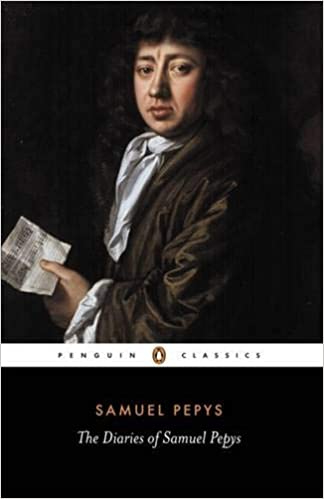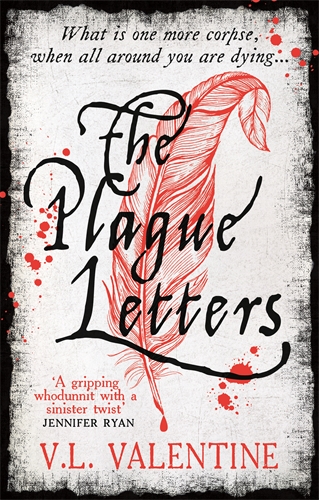V.L. Valentine is a senior science editor at National Public Radio in Washington, D.C. The Plague Letters is her first novel, out April 1 from Viper Books.

It’s not a stretch these days to imagine this scene.
Let’s pick a sunny, breezy June day in London. Midsummer. Before Covid-19. It’s been a busy day – the normal stress. Accounts aren’t adding up in your favour. You’ve had to battle traffic to get to the other side of the city, where you meet with the advisors of a notoriously fickle client (he insists on living in a palace he can’t afford).
But after all that, before heading home, you stop for a pint at the Cross Keys tavern near Cripplegate. Once on the tavern bench, you start to feel better. Besides, your mother is finally going home tomorrow.
Then, you look out the window; spit out your ale. Whitecross Street - the road leading north away from London - is clogged with wagons and coaches. It looks as if all of town is leaving. And you know why – plague. There’s no denying it, there are enough cases around Westminster and the parishes outside London’s western wall that it’s clear the pestilence is upon you.
What happens next – may or not seem a stretch, either, depending on your personality.
Do you join the exodus? In this case, no. The scene above is taken from the June 21, 1665 diary entry of Samuel Pepys.
He takes in the chaos outside the tavern, knows the import of it, then sticks around to flirt with (or harass) the tapster’s wife: ‘Here I had some of the company of the tapster’s wife for a while.’

Pepys’ diaries were one of my jumping off points for my novel, The Plague Letters. Because he does not behave as I would’ve expected when death drops down onto London that hot, dry summer of 1665. He does shortly after that entry send his wife out of town, but he stays behind for several more months. To make money and to flirt – or again, abuse - the women working in shops and taverns, or servants, who can’t afford to leave.
The Plague Letters is a medical mystery – someone is experimenting on plague victims. Why? But the backdrop for the book is the trajectory over that summer of that last great plague epidemic to ever hit London. Bubonic plague never bothered London much after that year; no one’s sure why.
I learned about this outbreak while getting my master’s degree at University College London’s Wellcome Trust Centre for the History of Medicine. And it was accounts like the one above that caught my eye. People doing the unexpected.
Here’s another one, from a letter written on September 23, 1665:
‘My Friend,
You see already that I am still alive, and it seemes I cannot live but I must have a little love for you…. you will hold mee here, if it bee possible, and hope to keep me alive by making mee desire it…’
Reads like a love letter, no? Nothing surprising there. Except it was written by a preacher to a married woman. The Rev. Symon Patrick, rector of St Paul’s Church in Covent Garden, had stayed behind to help his parish during the epidemic, and during that time, often wrote to his friend, Mrs Elizabeth Gauden, who was waiting out the plague at her sister’s house in what was then called Burntwood, in Essex.
SYMON PATRICK
Symon Patrick writes with real longing. Desire, loneliness, fear, jealousy, a need to impress. When they finally meet again, he teases her, “Instead of a skeleton, which I believe you fancy, you will meet with good flesh.”
I don’t know if they were having an affair – her letters didn’t survive. But there is enough said and unsaid in the letters that they set my imagination on fire.
But the problem was the letters only went so far. Patrick wrote mostly about love and God that plague season. Luckily, Pepys wrote about everything – providing me with much more of the mood on the streets:
‘I met this noon with Dr Burnett, who told me, and I find in the newsbook this week that he posted upon the ’Change, that whoever did spread the report that, instead of the plague, his servant was by him killed, it was forgery, and shewed me the acknowledgment of the master of the pest-house, that his servant died of a bubo on his right groine, and two spots on his right thigh, which is the plague.’
Pepys and Patrick are so descriptive in their writings, so alive and bruisingly human, that they opened up their world for me. The strangeness of the past, a world we will never see, takes on a different quality when they take you by the hand. They give you comfort. They are long dead, and yet their message is clear: we are not alone.
Their emotions and doubts raged just as ours do today. That the riled-up or conflicting emotions, contradictory behaviours we’ve seen this pandemic year have been with our species all along. I’m not in any way smoothing over mistakes of the past or present when I say this. My point is only to say these problems have been with us for some time. Small example, Patrick went on to be Bishop of Ely. He left thousands of pages of writings behind. It’s clear he was a devout man, an intelligent man, thoughtful. Yet he also broke city orders and hid the first plague deaths in his parish; and later kept it a secret that his parish clerk’s family had plague, otherwise they would’ve have been shut up in their house.
There is hubris in Pepys - an excess, even; and there is a gentler hubris in Patrick - in my opinion, his faith that God is fully in charge. And then there is my own hubris. I started this novel because I was curious to know how in the hell people got by during such an awful, concentrated and lethal outbreak, something I was 100 percent confident I would never witness. That I would always be a stranger to such a situation.
I thought, we know too much these days about pathogens, how to prevent spread, control outbreaks, how to keep patients alive with supportive care such as IVs, oxygen, ventilators.
Yet. In the U.K., more than 126,000 people have died from Covid-19 in a year. In the U.S., where I live, more than 500,000 people have died and the pandemic is far from over. Scientists who study coronaviruses say it won’t be long before we see another one.
Stephen Thornley .... "this novel is as disturbing and as prescient as one would wish for." Read SHOTS' review

Publication date: 01/04/2021
£14.99
ISBN: 9781788164535
Imprint: Viper Books